| Hex | Binary |
| 1 | 0001 |
| 2 | 0010 |
| 3 | 0011 |
| 4 | 0100 |
| 5 | 0101 |
| 6 | 0110 |
| 7 | 0111 |
| 8 | 1000 |
| 9 | 1001 |
| a | 1010 |
| b | 1011 |
| c | 1100 |
| d | 1101 |
| e | 1110 |
| f | 1111 |
As more kings are dealt, you swap the zeroes in the binary number with ones. At any point, you can tell from the binary number which kings have been dealt and which are still in the pack. Technically, when a new king is dealt you are "Or"-ing the number with either 8, 4, 2 or 1.
To start with, you will need to keep converting the hex number to binary in order to fill in another bit, and then convert it back to hex in order to remember it. With more practice, you will be able to alter the hex number directly without needing to convert to and from binary. It can be hard to do this quickly at first, but it gets a lot easier as you do it more often. There are some useful facts that help with this:
- If you get a new diamond, you know that you only have to add 1 to the number in your head.
- It becomes easier to convert from hex to binary if you think of the patterns. For example, "c" is "1100" whilst "3" is "0011".
- If you have "7", then you know you are waiting for the spade.
- If you have "e", then you know you are waiting for the diamond.
- If you have "f", then you have all of that type of card.
The easiest way to develop the method is to start by remembering just kings, queens and jacks. By doing that, you will have just three hex digits to remember, and you can concentrate on the maths instead of the remembering. When you are proficient with three digits, you can practise remembering longer sequences of digits.
A simple example
Here we will just keep track of the kings and queens. This means that we only have to remember two letters or numbers.Here are all the kings and queens shuffled:
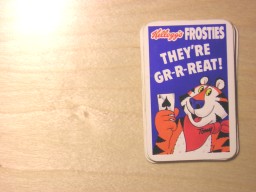
We have no kings or queens of any suit. At the moment, our grid looks like this:
| Spades | Clubs | Hearts | Diamonds | |
| Kings | 0 | 0 | 0 | 0 |
| Queens | 0 | 0 | 0 | 0 |
The king number is "0000" in binary, which is "0" in hex. The same is true for the queen number. Therefore, we just remember the king number followed by the queen number, which is "00".
Next, the first card is turned over:
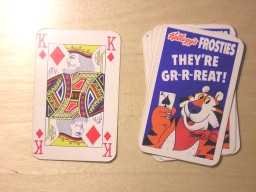
This is the king of diamonds. We fill its entry in our grid.
| Spades | Clubs | Hearts | Diamonds | |
| Kings | 0 | 0 | 0 | 1 |
| Queens | 0 | 0 | 0 | 0 |
The king number is now "0001" in binary, which is "1" in hex.
The queen number is still "0000", which is "0" in hex.
Therefore, we just remember the king number followed by the queen number, which is "10".
The next card is turned over:
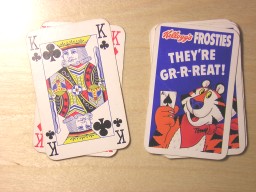
This is the king of clubs. We fill its entry in the grid:
| Spades | Clubs | Hearts | Diamonds | |
| Kings | 0 | 1 | 0 | 1 |
| Queens | 0 | 0 | 0 | 0 |
The king number is now "0101" in binary, which is "5" in hex.
The queen number is still "0000", which is "0" in hex.
As before, we just need to remember the king number followed by the queen number, which is "50".
The next card is turned over
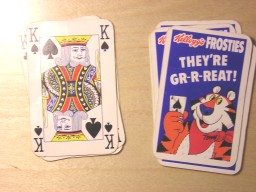
The card is the king of Spades. We set the relevant entry in the table to one:
| Spades | Clubs | Hearts | Diamonds | |
| Kings | 1 | 1 | 0 | 1 |
| Queens | 0 | 0 | 0 | 0 |
The king number is now "1101" in binary, which is "d" in hex.
The queen number is still "0000", which is "0" in hex.
The number we have to remember is "d0".
The next card is turned over:
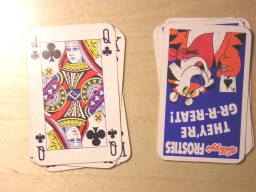
The card is the queen of clubs. Our table now looks like this:
| Spades | Clubs | Hearts | Diamonds | |
| Kings | 1 | 1 | 0 | 1 |
| Queens | 0 | 1 | 0 | 0 |
The king number is still "1101" in binary or "d" in hex.
The queen number is now "0100", which is "4" in hex.
The number we have to remember is "d4".
The next card is turned over:
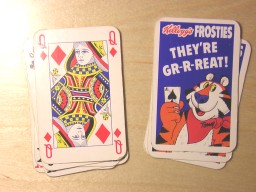
It is the queen of diamonds. Our table now looks like this:
| Spades | Clubs | Hearts | Diamonds | |
| Kings | 1 | 1 | 0 | 1 |
| Queens | 0 | 1 | 0 | 1 |
The king number is still "1101" in binary or "d" in hex.
The queen number is now "0101", which is "5" in hex.
The number we have to remember is "d5".
The next card is turned over:
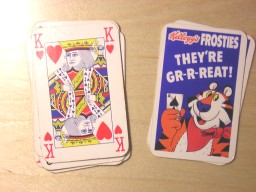
It is the king of hearts. Our table now looks like this:
| Spades | Clubs | Hearts | Diamonds | |
| Kings | 1 | 1 | 1 | 1 |
| Queens | 0 | 1 | 0 | 1 |
The king number is now "1111" in binary, which means that we have all the kings. This is "f" in hex.
The queen number is still "0101" or "5" in hex.
The number we have to remember now is "f5".
Now we can make the best use of this method of remembering cards. We know which cards have been dealt, and we can work out which cards are left in the pack by just seeing where the zeroes are in the table. We have all the kings, which we can tell by the king number being "f" or "1111" in binary. The queen number is "5", which is "0101" in binary. This means that we are still waiting for the queen of spades and the queen of hearts.
Turning over the last two cards, we can see that we were right:
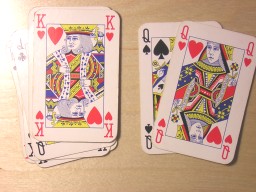
If you have an entire pack of cards, and remember all the kings, queens and jacks as you go through it, then you can slightly impress people by saying which of these are left in the pack at any moment in time. The more rows you can add to the table in your head, the more impressive it is. People generally assume you are performing a trick, but they might be more impressed if they knew what you were really doing.
I don't know enough about card games to know how useful it is to remember a portion or all of a pack of cards, but it's still an interesting pursuit.
[Go to main page]
[Contact]